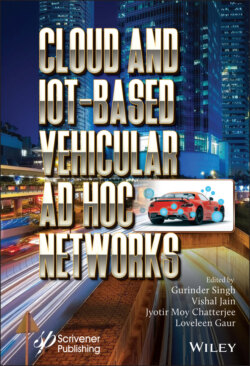Читать книгу Cloud and IoT-Based Vehicular Ad Hoc Networks - Группа авторов - Страница 38
2.1 VANET
ОглавлениеVANET milieu recedes into the context of the Internet of Things, which provides consumers with relevant information and services at any moment, everywhere [1, 2]. Without sufficient understanding of the discovery mechanism, retrieving the efficient service is a big task. VANET is distinguished into infrastructure (IF) and infrastructure-less (IFL) networks. The IF network is dependent on the fixed elements. The IFL (Ad Hoc) networks are a lightweight network with no fixed components, where the mobile node is capable of interacting with each other within its coverage area [3].
As shown in Figure 2.1, in VANET each node (vehicle) is proficient in communicating with other nodes and access points within its range [3]. The most important VANET communication modes are Vehicle-To-Infrastructure (VTI), Vehicle-To-Vehicle (VTV), Vehicle-To-Network (VTN), and Vehicle-To-Pedestrian (VTP) communication modes [4]. The VTI and VTP communicate between vehicles and pedestrians without the concern of roadside and network infrastructure. In VTI, the vehicle communicates with the aid of roadside and network infrastructure. The VTN communicates between vehicles and networks by sustaining the vehicle-to-network applications.
The VANET uniqueness is as follows:
Communication power: Each vehicle in VANET milieu affords the limitless power for computing and communications.
Predictable mobility: The vehicles travel on the roadways. The vehicle acquires the roadway information from the GPS.
Mobility: The VANET milieu is completely dynamic. On the highways-low busy roads, the speed of the vehicle is up to 300 km per hour and the density may be one to two vehicles per kilometer. At city-peak hours, the velocity of the vehicle is up to 180 km per hour and the total number of the vehicle will be extremely high.Figure 2.1 VANET Milieu.
Network topology: As VANET milieu is high in mobility, the frequent topology changes occur which breaks the links between nodes often [5].
Network connectivity: Network connectivity depends on the wireless links ranges [6].
Some of the research issues in the VANET milieu are multicasting, service discovery, addressing, security, privacy, routing, medium access schemes, self-organizing, reliability, pricing scheme, scalability, and so on [7, 8].
The communication technology in VANET can be classified based on their signal range. They are Long Signal Range (LSR), Medium Signal Range (MSR), and Small Signal Range (SSR). LSR communication technologies are Microwave, Mobile Broadband Wireless Access (MBWA), WiMAX (Worldwide Interoperability for Microwave Access), and cellular technologies such as 2G, 3G, 4G, and 5G [8]. The ASR communication technologies are Continuous Air-Interface, Long and Medium Range (CALM), Dedicated Short Range Communication (DSRC), and Wireless Fidelity (Wi-Fi) [33]. The SSR communication technologies are the Ultra Wide Band (UWB), Zigbee, Bluetooth, and Infrared [33].
